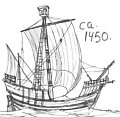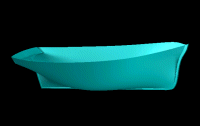|
The development of ship types is reflected in the shipfinds, Nordic and worldwide, and their replicas. Wooden shipsThe first boats were probably logboats, rafts and skinboats. The earliest logboats in Europe are 8-9000 years old. Early planked boats were often sewn or stitched together. Ships of Antiquity were assembled by the mortise and tenon fashion. From Medieval times, planks were fastened with wooden pegs or iron rivets. The first sailing ships probably appeared in Egypt or Mesopotamia around 3500 BC. Really large ships were constructed in imperial Rome, capable of loading up to ca 1000 tons. A famous large ship of antiquity was the Syrakosia of Alexandria, a three-masted royal ship, about 70 m long. Large ships were also made around 1000 AD in China, also loading up to ca 1000 tons. In the Mediterranean, the square sail disappeared in the 6th century and reappeared in the 14th century. In the mean time, the triangular lateen rig was dominant. Until the Middle Ages, all Nordic ships were clinker built using the shell-first method. The logs were split radially, and the planks had to be shaped with an axe. Only later, planks were sawed. The changes were driven partly by cog, and by the carvel-built hull which from the 15th century was necessary for warships to support guns. Carvel-built ships were usually built with the skeleton-first method. In the Nordic countries, where wood is abundant, commercial wooden shipbuilding existed until recently. Fishing trawlers were made of wood in Sweden until the 60s, and in Denmark and Finland until the 80s. There are possibly some shipyards in Norway that still build fishing trawlers with wood, using modern laminated wood/glue technology. Wooden construction of small ships was practised as late as the 1980s in Scotland. Possibly as late as the 1980s (and perhaps still) in Spain, Greece, Maine and Nova Scotia. In Portugal, fishing boats are still, in the 1990s, made of wood in Vilamoura (Algarve) and in Peniche. Wooden shipbuilding is also common in other parts of the world, e.g. Egypt and India. Paddles and propellersIn 1807 the American Robert Fulton created the first steam-driven ship. It had a wooden hull and used paddles. Around 1830, ships propellers were gradually developed by several inventors, including Josef Ressel, John Patch and Francis Pettit Smith. During the next 150 years, steam or combustion engine ships would compete against sail. The last great sailing ships were in service in South America in the 1950s. Iron and steelDuring the 19th century, iron and steel gradually took over the wooden hull production. Steel was preferred since it is stronger than iron, and from the 1870s, steel was used instead of the weaker wrought iron plates. The first iron and steel hulls were riveted, but from the 1940s and onwards, steel ships are usually welded. by Per Åkesson
|
|







 Back to Replicas & Shipbuilding
Back to Replicas & Shipbuilding Back to Nordic Underwater Archaeology
Back to Nordic Underwater Archaeology